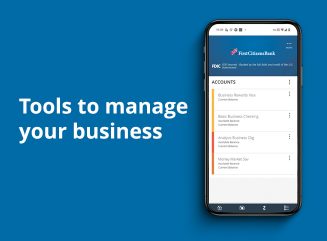Digital banking for business
Seamlessly access all of your accounts from one place with First Citizens Digital Banking for business.

Invest how you want, when you want, in real time with Self-Directed Investing.

Seamlessly access all of your accounts from one place with First Citizens Digital Banking for business.
We're committed to serving companies as they expand and succeed. The proof is in our success stories.
2026 Market Outlook video: Available now
The Making Sense team reflects on 2025 and discusses key headwinds and tailwinds for 2026.

Business fraud is a serious threat that can damage a business's reputation, finances and operations. Understanding the risks and implementing strong prevention strategies is essential to protecting your organization.

Phishing uses email, SMS, phone, social media and social engineering to entice a victim to share sensitive information, which can lead to unauthorized financial transactions or identity theft. Never open any unexpected links or attachments, even if they appear to come from a trusted individual.
This involves receiving a message from someone posing as a friend or family member asking you to wire money to get them out of a dire situation.
The individual receives a threatening letter, email or phone call demanding payment for a debt they've never heard of.
Invoice fraud attempts to trick a business into paying a fake invoice or a legitimate invoice to a fake account by impersonating a vendor or partner.
Ransomware is a type of malicious software that prevents users from accessing their computer files, systems or networks—and then demands they pay a ransom for their return.
Be skeptical of unexpected emails, messages or phone calls—especially those asking for personal or financial information.
Use strong passwords and additional forms of authentication where possible. Shred documents before discarding them. Limit information shared on social media because this information can be use to target victims.
Be cautious of unsolicited requests, and adopt a proactive approach to understanding scam tactics. If it's too good to be true, it usually is.
Independently verify the identity of the contact, don't trust caller IDs and be cautious of names and titles.
Regularly update operating systems, browsers and antivirus software to protect against the latest security threats.
Regularly check bank and credit card statements for any unauthorized activity.
Links to third-party websites may have a privacy policy different from First Citizens Bank and may provide less security than this website. First Citizens Bank and its affiliates are not responsible for the products, services and content on any third-party website.
Bank deposit products are offered by First Citizens Bank. Member FDIC and an Equal Housing Lender. icon: sys-ehl.
NMLSR ID 503941

Treasury & Cash Management
Electronic Bill Presentment & Payment
Investment & Retirement Services
Community Association Banking
Equipment Financing & Leasing
Credit Cards
Merchant Services
Email Us
Please select the option that best matches your needs.
Customers with account-related questions who aren't enrolled in Digital Banking or who would prefer to talk with someone can call us directly.